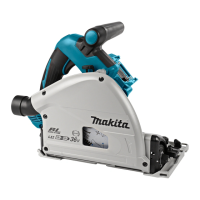11 ENGLISH
Guard function
1. Check the guard for proper closing before
each use. Do not operate the saw if the guard
does not move freely and enclose the blade
instantly. Never clamp or tie the guard so that
the blade is exposed.Ifthesawisaccidentally
dropped, the guard may be bent. Check to make
surethattheguardmovesfreelyanddoesnot
touch the blade or any other part, in all angles and
depthsofcut.
2. Check the operation and condition of the
guard return spring. If the guard and the spring
are not operating properly, they must be ser-
viced before use.Theguardmayoperateslug-
gishly due to damaged parts, gummy deposits, or
abuild-upofdebris.
3. Assure that the base plate of the saw will not
shift while performing a “plunge cut”. Blade
shiftingsidewayswillcausebindingandlikelykick
back.
4. Always observe that the guard is covering the
blade before placing the saw down on bench
or oor.Anunprotected,coastingbladewillcause
the saw to walk backwards, cutting whatever is in
itspath.Beawareofthetimeittakesfortheblade
tostopaftertheswitchisreleased.
Additional safety warnings
1. Use extra caution when cutting damp wood,
pressure treated lumber, or wood containing
knots.Maintainsmoothadvancementoftoolwith-
out decrease in blade speed to avoid overheating
thebladetipsandifcuttingplastics,toavoidmelt-
ing the plastic.
2. Do not attempt to remove cut material when
blade is moving. Wait until blade stops before
grasping cut material.Bladescoastafterturnoff.
3. Avoid cutting nails. Inspect for and remove all
nails from lumber before cutting.
4. Place the wider portion of the saw base on
that part of the workpiece which is solidly
supported, not on the section that will fall off
when the cut is made. If the workpiece is short
or small, clamp it down. DO NOT TRY TO HOLD
SHORT PIECES BY HAND!
►Fig.5
5. Before setting the tool down after completing a
cut, be sure that the guard has closed and the
blade has come to a complete stop.
6. Never attempt to saw with the circular saw
held upside down in a vise. This is extremely
dangerous and can lead to serious accidents.
►Fig.6
7. Some material contains chemicals which may
be toxic. Take caution to prevent dust inhala-
tion and skin contact. Follow material supplier
safety data.
8. Do not stop the blades by lateral pressure on
the saw blade.
9. Do not use any abrasive wheels.
10. Only use the saw blade with the diameter that
is marked on the tool or specied in the man-
ual.Useofanincorrectlysizedblademayaffect
theproperguardingofthebladeorguardopera-
tionwhichcouldresultinseriouspersonalinjury.
11. Keep blade sharp and clean. Gum and wood
pitch hardened on blades slows saw and
increasespotentialforkickback.Keepbladeclean
byrstremovingitfromtool,thencleaningitwith
gum and pitch remover, hot water or kerosene.
Never use gasoline.
12. Wear a dust mask and hearing protection when
use the tool.
13. Always use the saw blade intended for cutting
the material that you are going to cut.
14. Only use the saw blades that are marked with
a speed equal or higher than the speed marked
on the tool.
15. (For European countries only)
Always use the blade which conforms to
EN847-1.
SAVE THESE INSTRUCTIONS.
WARNING: DO NOT let comfort or familiarity
with product (gained from repeated use) replace
strict adherence to safety rules for the subject
product. MISUSE or failure to follow the safety
rules stated in this instruction manual may cause
serious personal injury.
Important safety instructions for
battery cartridge
1. Before using battery cartridge, read all instruc-
tions and cautionary markings on (1) battery
charger, (2) battery, and (3) product using
battery.
2. Do not disassemble battery cartridge.
3. If operating time has become excessively
shorter, stop operating immediately. It may
result in a risk of overheating, possible burns
and even an explosion.
4. If electrolyte gets into your eyes, rinse them
out with clear water and seek medical atten-
tion right away. It may result in loss of your
eyesight.
5. Do not short the battery cartridge:
(1) Do not touch the terminals with any con-
ductive material.
(2) Avoid storing battery cartridge in a con-
tainer with other metal objects such as
nails, coins, etc.
(3) Do not expose battery cartridge to water
or rain.
A battery short can cause a large current
ow, overheating, possible burns and even a
breakdown.
6. Do not store the tool and battery cartridge in
locations where the temperature may reach or
exceed 50 °C (122 °F).
7. Do not incinerate the battery cartridge even if
it is severely damaged or is completely worn
out. The battery cartridge can explode in a re.
8. Be careful not to drop or strike battery.
9. Do not use a damaged battery.

